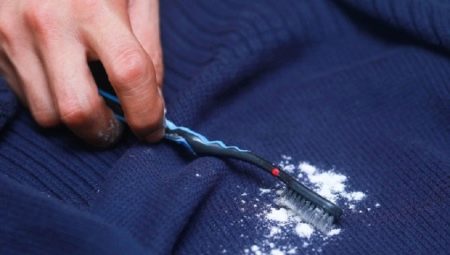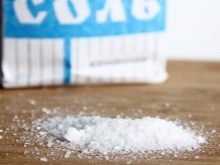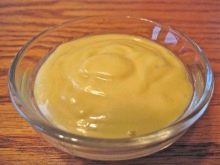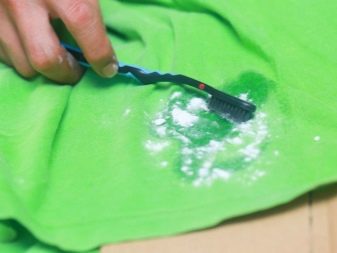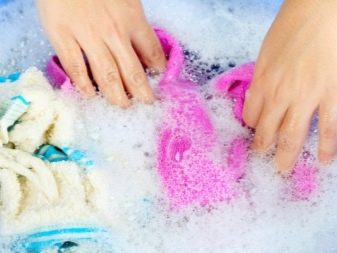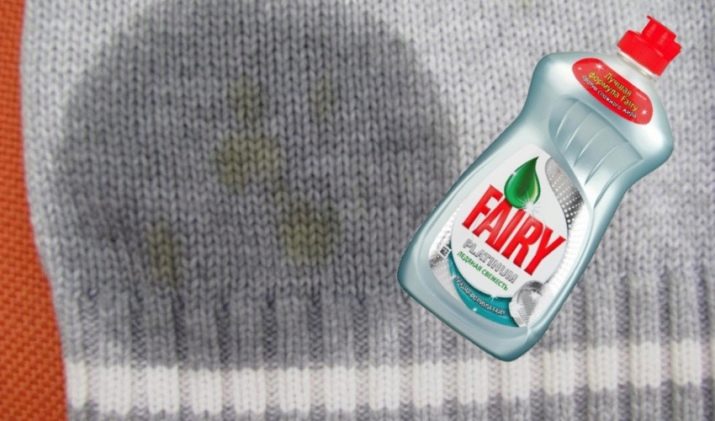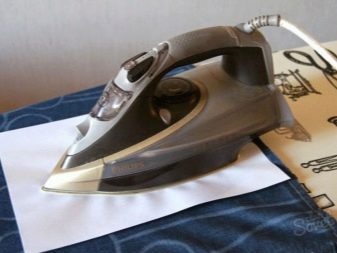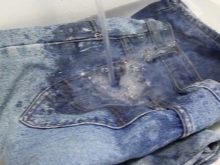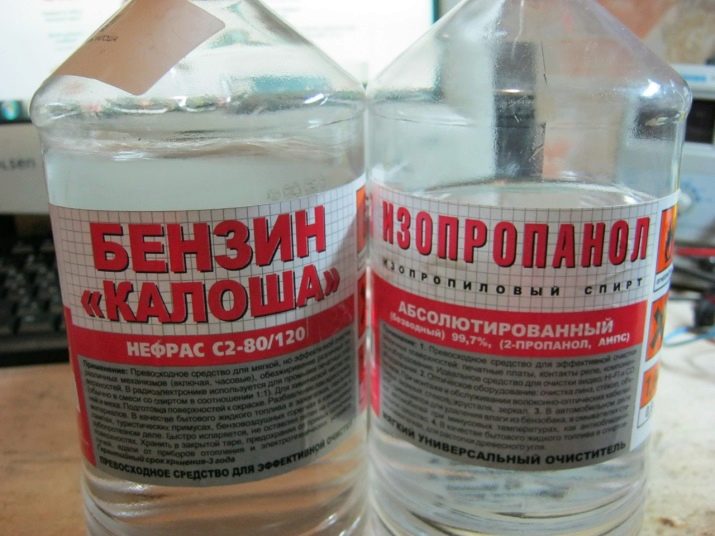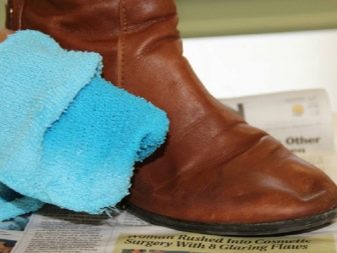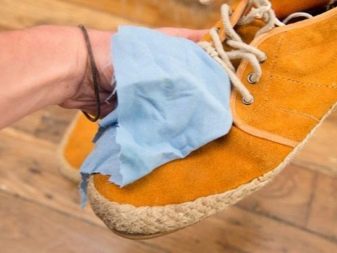The risk to put a stain on a jacket or a suit is at everyone. With the expansion of the scope of application of various chemicals on clothing pollution wipe harder. Sometimes it is difficult to guess what substance left a mark on your clothes. Oil stains are among the most difficult to remove. But there is always a way out. To remove stains from oils, many household tools at hand fit: salt, soda, alcohol, sal ammoniac, toothpaste, dishwashing liquid, soap, flour, and even mustard. Of the more powerful compounds applicable gasoline, kerosene, solvents, acetone. The stores have a wide range of stain removers of different composition and purpose.
Types of pollution
In order to remove oil pollution as quickly and safely as possible, it is necessary to understand what type of oil you have encountered.
Sunflower oil is the most common source of greasy stains. Catching up in the kitchen, dining in a restaurant or eating a hamburger on the go, you can get a stain on him on clothes. Purchased stain removers do not always guarantee a good result. Therefore it is worth resorting to some folk remedies to remove stains:
- The most common remedy for the fight against vegetable fats is soap. Lather them well with a cloth and soak for a day. After that you should rinse the item.
- Sugar can be added to the laundry soap. Rub the soap into the damaged area and apply a layer of sugar. It is better to additionally clean the dirt with a brush and leave the composition on the surface for 20 minutes. Then be sure to wash the thing in the usual way.
- Salt treatment is an easy way to remove sunflower oil. It is necessary to apply its layer to the surface and allow excess fat to be taken away. To enhance the effect, you can iron this area with a hot iron through a sheet of white paper. Under the influence of temperature, the salt absorbs the stain more quickly.
- Treatment with dishwashing liquid: apply a small amount of the product onto the dirt and rub it with a napkin or soft brush. After 15 minutes, rinse clothes.
Mustard powder should be mixed with water and the resulting paste spread over the treated surface. Allow the tool to dry and remove any residue with a brush or knife. Then wash the clothes as usual.
Vaseline is used in cosmetology and for the care of newborns. Remove the stain of vaseline with clothes is not so simple. To do this, you can use gasoline. Apply the product on a cotton swab and treat it with dirt, then sprinkle with talcum powder. When the stain dries, remove the rest of the powder with a scraper or a stiff brush.
During processing, it is worthwhile to put a clean white cloth under the product. If traces of contamination remain, they can be cleaned with an aqueous solution of oxalic acid. With a cloth soaked in a solution, you need to scrub the stain and rinse the cloth.
Lampad oil is very difficult to remove from the fabric. It is worth using a strong purchased stain remover with organochlorine. Interesting way to handle aerosol WD-40. Lay layers of soiled and clean clothes with cardboard sheet. This will protect clean tissue areas from excessive exposure to chemicals and oil residue. Then spray the contaminated area with a spray.
After that, apply plenty of baking soda to the contaminated area. Using a soft bristled brush, rub it into the fabric. When it begins to roll into lumps, stop rubbing and remove the remaining soda powder.If the soda remains on the surface, then with the first wash it will be removed without problems. Oil stains must be treated with dishwashing liquid. At the end of all these manipulations it will be enough to wash the thing as usual.
Castor oil is very fatty in its structure. It is used in medicine and cosmetology. An oil stain of this kind can be removed using chalk. Crush it to a powdery state, put it on the clothes on each side and put it in paper sheets. Put a heavy object on the paper and let it soak for a day. After that, remove the remaining chalk from the product. But for dark things you need to handle powder on the wrong side.so as not to spoil the thing.
The scope of flaxseed oil is huge - medicine, pharmacology, cosmetic and food industry, furniture production. It is absorbed in clothes very much. There are spots of yellow-brown color. But not only this makes the removal of traces of flaxseed oil problematic. After its impact remains a persistent smell of linseed oil. The best stain removers in this case are gasoline products.
Gasoline should be applied to the surface, and the place of contamination should be treated with a cloth impregnated with benzene. Then rub into the fabric gasoline soap and clean with gasoline. The remaining traces of oil should be removed with talcum powder. If after all the manipulations the stain does not appear until the end, then It is necessary to further treat the surface with gasoline soap and leave to soak for a day.
Clothes should be thoroughly washed and rinsed after gasoline treatment to get rid of the smell. It is better to pre-rinse things in the basin, and then wash them in the car so that there are no traces of oil products and their smells left in it.
Technical oil formulations can rarely stain home clothes. Unless you repair the sewing machine or grease loops with a special compound. In the garage or at work, associated with the repair of the car, there is a danger of getting dirty with gear oil. Transformer, hydraulic oil can be put on clothes at work in the energy industry or at the pumping station. Of course, professionals at work are provided with workwear that does not need to be washed to perfect condition. But there are situations when it is necessary to remove technical oil from the surface. It leaves clear brown marks on the fabric. Due to its strong viscosity, the compositions are very firmly embedded in the material.
Laundry soap and Fairy can help here, as well as store stain removers, but you can use refined gasoline or kerosene. It is necessary to apply a liquid to a cloth or cotton wool and to wipe off the pollution from the edges to the middle. This will prevent the spreading of oil over a larger surface. After processing, wash the thing in the machine. The second method is the preparation of a mixture of ammonia and turpentine, taken in equal shares. Treat the place of contamination and let it soak for 15-20 minutes. After that, it is better to rinse the clothes separately to eliminate the persistent smell, and only then wash them in the machine.
We clean different types of fabrics
The specifics of the materials from which your clothes are sewn, make it necessary to consciously approach the choice of means for removing oil.
Synthetic absorbs less pollution. Clothes from it will be easier to wash. There may be enough store stain removers. It is also possible to influence pollution by an iron heated to a low temperature. Stroking the thing through the paper, into which the pollution is absorbed.
Things from natural materials (cotton, linen, silk) try to remove the powder from the chalk. Scatter it on the surface of the pollution, rub and leave for a few hours. Then the remnants of funds need to be removed and wash clothes in a typewriter as usual.
Delicate fabrics require a special approach, because rubbing them with abrasive powders and brushes is impossible. It is also desirable to exclude various solvents. Glycerin comes to the rescue. It is combined with ammonia in a ratio of 1 to 1 and soak the damaged place in the resulting solution. After that, you should wash the thing in hot water with your hands.
White linen and things can be treated with oxygen bleach. You can soak a thing in it for a long time, but you need to remember that bleachers negatively affect the resistance of the fabric. Soda will also work well on light things. Prepare a paste of soda and water, taken in equal parts, and apply to the stain. The solution should be allowed to work for 10-15 minutes and remove with a damp cloth. Another way - processing cleaner plumbing. It is poured on a cloth and rubbed with a brush. Then remove with a wet cloth or sponge. Toothpaste due to its whitening properties can also help. Spread it over the spot, leave for 15 minutes and rinse with clean water.
Outerwear requires special frugality. Bolonev jacket washed with the help of most of the above methods. In a safe way, it can be treated with vinegar. Apply it to pollution, and then wash things. Leather products can be wiped with medical alcohol.
Denims absorb oil very strongly, so you need to get rid of stains as quickly as possible. In this case, you can use chalk, starch or dishwashing detergent.
If the stain is already dry, try soaping the cloth with laundry soap and leaving it for 12 hours, then washing.
To remove traces of vegetable oils at home will help shampoo for greasy hair. Pour it on the stain and hold it for an hour. Then rinse things. Oil stains can be treated with a mixture of turpentine and ammonia. Treat the compound with a cloth wipe and let the material soak for 3 hours. Then wash the product as usual.
Fresh pollution is always easier to remove. After the stain has formed, blot it with a tissue to remove excess oil. The newly formed pollution can be affected by powders with good absorbing properties - soda, chalk, baby powder, salt.
Old stains can be very difficult to remove and sometimes impossible without a trace. Therefore, if the fabric is delicate or the item is expensive, better use the services of dry cleaning. In any case, it is necessary to resort to potent chemicals.
Gasoline, acetone, solvents should be applied carefully. If the fabric is complex, it is better to remove stubborn dirt from the wrong side. The dried-up stain is removed by glycerin. A little solution is applied to the surface, left to soak and moisturize for half an hour, and then removed with a damp cloth or cotton swab.
Universal remedy to remove oily oily stains - home stain remover. Combine 20 ml of gasoline, 30 ml of ammonia, 60 ml of alcohol and process contamination with this mixture. Leave the mixture for half an hour, then wash the clothes.
How to wash shoes?
Shoes, as a rule, should not be washed and strongly exposed to water. Therefore, for her at home, the range of possibilities is not so great.
Oil can be scrubbed from leather shoes with dishwashing liquid. Another proven recipe is a mixture of 100 ml of distilled water, a tablespoon of sea salt, half a teaspoon of flour and 1 tablespoon of baking soda. All this must be combined and carefully moved to a uniform consistency. Using a cloth napkin, treat the damaged area with this compound. You need to wait 15-20 minutes, then remove the mixture with a clean cloth.
Suede requires delicacy in processing. Try to use river sand. It is necessary to heat it in a griddle and place it in a fabric bag or sock made of natural light-colored material and apply it to the contamination.Wait until the stain is absorbed or the contents of the bag have cooled. The procedure must be repeated until the spot disappears. In the same way you can remove the oil with salt.
Another option for suede shoes - liquid soap combined with ammonia in the ratio of 1 to 1. Create a foam and dilute the mixture with warm water. Using a sponge, apply the product on the dirt and leave it to absorb. Then remove the remaining liquid and leave to dry.
Suede and leather shoes can be cleaned with special compositions sold in specialized stores.
Tips and tricks
Hostess for a note a few tips:
- It is better to remove the stain immediately, until it is absorbed and dried.
- Wear gloves to protect your skin from potent formulations.
- Study the labels on clothes, so as not to spoil it.
- If you are not confident in your abilities, it is better to contact a dry cleaner.
- After processing the oil traces, the thing is better to pre-rinse in the pelvis. So the washing machine will not get the smell of oil and solvents.
- If you are not sure about the composition of the fabric, it is better to choose careful cleaning methods.
How to remove stains from various types of oil, see the following video.
